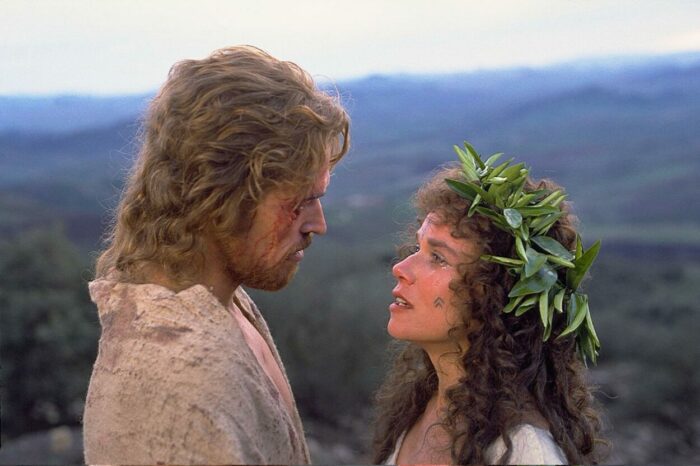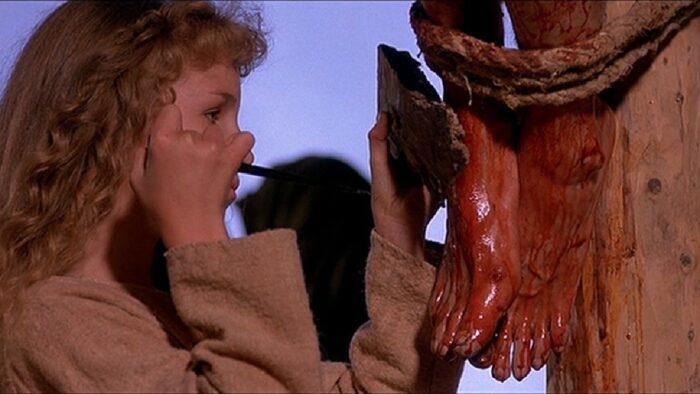Welcome to this column dedicated to my appreciation of physical media supplements called Feature Presentations. The goal of this column is not to say whether a film is good or bad and worth picking up or not: I would like to highlight the discs that go the extra mile and provide film fans with enough tasty tidbits to satisfy even the hungriest of cinephiles. Today’s article will focus on The Last Temptation of Christ from the “Martin Scorsese Films of Faith” collection via Imprint Films.

I never have or will claim to be an expert in reviewing the technical specs of a physical media release. There are plenty of knowledgeable people in this realm of commenting on the audio and video aspects of a disc with better setups than I’ll ever own. This column, Feature Presentations, is a way of highlighting the supplemental material within a given disc. With all that out of the way, let’s get to the good stuff and dive into my review of this Blu-ray release of The Last Temptation of Christ.
As a disclaimer of transparency for this episode of Feature Presentations, my review of The Last Temptation of Christ comes from a review copy that Imprint Films provided for review. All thoughts and opinions are my own.
I’m ashamed to admit it, but until I sat down for this review, The Last Temptation of Christ was a film that escaped me. It is a slice of cinema I’ve wanted to sink my teeth into, but until now, it never came to fruition. And boy, was I missing something!
Based on the novel of the same name by Nikos Kazantzakis, The Last Temptation of Christ tells the biblical story of Jesus, wonderfully played by Willem Dafoe, as he struggles with human temptation and the internal and external conflicts of someone conflicted with the idea of humanity and the divine.
I never try to take personal feelings into a movie in an attempt to go in as pure as possible. I do not come from a religious background; I’m a strict athiest with many negative feelings about the ideas of religion. That’s here nor there, so I did my best to keep the contempt I have toward the Gospels and organized religion away, keeping my judgment as open-minded as possible.
Right from the get-go, it’s clear that this isn’t going to be an old school Hollywood epic filled with lavish sets, flowery dialogue and a preaching mentality. What you get is one of cinema’s greatest auteurs, tackling the oldest story in the book and crafting something wholly original while staying familiar. Scorsese uses actors, some familiar to past works, and others are first timers with the director, and leans into their strengths. The usage of unconventional actors for this story, a screenplay that tells a tale we’ve heard many times before, yet not in this way, gorgeous cinematography from Michael Ballhaus and a director in top form makes this an unforgettable work in Martin Scorsese’s filmography.
Disc one starts with a vintage interview with director Martin Scorsese, shot around the time of the film’s production. I’m usually apprehensive to vintage, “fluff piece” interviews, but when it comes to Martin Scorsese, any chance to hear him talk is a conversation worth listening to. Clocking in at around 13 minutes, the interview touches on Scorsese’s childhood with the clergy, how he came across Nikos Kazantzakis’ novel, and the resulting controversy from the church and those of religious faith for tackling such a hot-button issue. Of note are listening to how Scorsese approached The Last Temptation of Christ and understanding how and why he made specific choices. With this interview filmed around the time of The Last Temptation of Christ‘s release, we are offered a window in time and gain a perspective of Martin Scorsese’s thinking when the controversy and criticism for the 1988 movie were at its peak that we wouldn’t get in contemporary interviews. For an EPK-type interview, this is a must-listen.

Imprint Films also includes a newly-recorded audio commentary with film historian Jim Hemphill. Hemphill comes to the track prepared, filling the 163-minute runtime with an almost non-stop dispensing of stories, production details, and analysis. Following the usual steps of a commentator, Hemphill dives into topics on Martin Scorsese, the project’s genesis, spending considerable time discussing the aborted 1983 version and the religious controversies The Last Temptation of Christ elicited.
I’m a fan of audio commentaries, and I feel there is an art between what makes a commentary engaging and insightful versus a rote, by-the-numbers drone-fest. Hemphill’s commentary is one of the finest commentaries I’ve heard in a long time. The way he spaces out his information, his tone, and the choices of when to discuss specific topics at what points during the film gives this almost three-hour film an astute track that gives this underrated Scorsese masterpiece the commentary it deserves. I may be biased, as film production and cinema history are topics I find fascinating, but I’d be hard-pressed to find anyone who doesn’t find Hemphill’s words fascinating. Well done, Jim Hemphill and Imprint Films!
Disc one closes with the film’s theatrical trailer.
On disc two, the first feature is the visual essay, “As Above / So Below: The Last Temptation of Christ and the Devine Feminine. Written and narrated by the always-illuminating Kat Ellinger, she offers a viewpoint looking at the portrayal of Mary Magdalene and the change of view from her and Jesus’ characters as the film progresses. Ellinger discusses the sins Christ encounters through his journey and, upon temptation by Satan in the guise of a young girl makes a connection to the feminine divide seen throughout Scorsese’s film. If Kat Ellinger’s prior commentaries and visual essays have bypassed you on other physical media releases, The Last Temptation of Christ is a great place to start. And if you are familiar with Ellinger’s work, you know what quality awaits with “As Above / So Below.”
The next feature, “It is Accomplished: Scoring The Last Temptation of Christ,” is an interview with film music historian Daniel Schweiger. One of the finest things about The Last Temptation of Christ, of which there are many, comes in the form of Peter Gabriel’s score. Schweiger discusses Gabriel’s career, including the influence of the 1963 African drama Dingaka, up to his hiring as the film’s composer. From here, Schweiger alternates between musical breakdowns of the film’s score, the usage of unconventional methods, and navigating through what Gabriel looks to convey with his musical choices.
“The Gospel According to John and Andrew” is an interview with production designer John Beard and art director Andrew Sanders. Conducted at separate times and spliced together, both men discuss how they came aboard the production and offer stories and anecdotes from their time on set. Beard delves into how his work on The Life of Brian helped secure him the gig, his familiarity with Morocco, and the triumphs and challenges of the environment. Sanders recalls how Beard helped get him to work on the film, the dedication of Willem Dafoe and Martin Scorsese, and being there for Dafoe during the crucifixion scene. While the interview can be a bit dry, it’s still welcome to hear behind-the-scenes tales from those who had their boots on the ground during filming.
The last feature on the disc is a featurette with film scholar Ian Christie, author of Scorsese on Scorsese. Christie starts the feature off by discussing Scorsese’s childhood, his faith as an altar boy, growing up on the East Side of New York and transitioning the director’s childhood experiences and how that helped shape what would become The Last Temptation of Christ; in a way, as stated by Christie, Mean Streets applied to the gospels. Having written a book about the director and spent many hours with him, the knowledge Christie has of Scorsese is immense. He alternates between production details and shining a light on the filmmaker’s thought processes in a fluid way that keeps the chat lively and insightful. Hands down, this is my favorite feature on disc two.

And there you have it! Martin Scorsese’s The Last Temptation of Christ is a monumental film from the legendary director. Excluding the religious fervor that the movie can stir up, looking at it through a cinematic lens, it’s a damn good movie top-to-bottom. Imprint Films did the lord’s work by stacking this release with a terrific commentary, an insightful essay and a smattering of old and new interviews and kicking off the “Martin Scorsese Films of Faith” collection in style.



